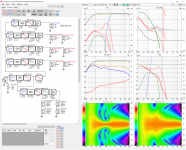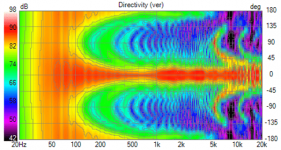I think you could be well satisfied with a full range driver line array. I was with mine. I used a 2.5" driver for a wider beam than provided by the TC9. You could go even smaller using e.g. Dayton DMA45, a 1.5" driver. But an expanded array with cardioid bass also might work for you. This simulation shows Mabat's ST-260 flanked by 3 pairs of 6.5" mid woofers using DSP FIR XO. Those drivers from Misco have an Xmax of 10 mm so it will have plenty of bass. Its an active cardioid with side drivers placed vertically between the front woofers. I had a speaker with just 2 pairs of miscos on the drawing board and added the 3rd pair to improve the VDIR. The 3 pair version will be almost 2m tall. Too much for me but I don't have your problem. Above one khz the beam widens to where it likely hits your MBR wall but 1 khz ++ is easy to absorb. The 2nd attached file is the simulated VDIR of my 32x2.5" driver line array. You see the cardioid expanded array does a better job in the low end but is narrower up top.
Attachments
These as in #1?..
With my own arrays..
https://www.diyaudio.com/community/threads/full-range-tc9-line-array-cnc-cabinet.303417/
//
Latest updates:
1) a CBT array of dipoles seems to look promising
2) a CBT array of cardioids also looks promising
3) I haven't been a big fan of the CBT concept, but something I noticed in the experiments I did yesterday is that it somehow seems to work better if it's asymmetrical instead of symmetrical. IE, a full arc seems like it would be the ideal solution and I've always focused on full-arc CBTs. But for some reason, the half arc (like Keele's CBTs) seems to work better. No idea why.
4) The thing that REALLY has me scratching my head, is that the JBL solution (which uses inductors instead of resistors) doesn't behave as I would expect it to. What I mean by this, is that in the JBL solution, where progressively larger inductor values are used at the edge of the array, I would expect the inductors would introduce a progressively larger delay. But it seems to be working BACKWARDS, which makes no sense to me at all. In other words - the larger inductors, at the edge of the JBL CBT, are actually LOWERING the delay. This is backwards to how I understand that inductors work. It is very possible that I'm misinterpreting how VituixCad simulates phase. I dunno.
1) a CBT array of dipoles seems to look promising
2) a CBT array of cardioids also looks promising
3) I haven't been a big fan of the CBT concept, but something I noticed in the experiments I did yesterday is that it somehow seems to work better if it's asymmetrical instead of symmetrical. IE, a full arc seems like it would be the ideal solution and I've always focused on full-arc CBTs. But for some reason, the half arc (like Keele's CBTs) seems to work better. No idea why.
4) The thing that REALLY has me scratching my head, is that the JBL solution (which uses inductors instead of resistors) doesn't behave as I would expect it to. What I mean by this, is that in the JBL solution, where progressively larger inductor values are used at the edge of the array, I would expect the inductors would introduce a progressively larger delay. But it seems to be working BACKWARDS, which makes no sense to me at all. In other words - the larger inductors, at the edge of the JBL CBT, are actually LOWERING the delay. This is backwards to how I understand that inductors work. It is very possible that I'm misinterpreting how VituixCad simulates phase. I dunno.
An un-tapered array of ~2.5m length will give you a greater drop in level above the array than a CBT or other tapered array.
Near field bass would work well below 80Hz without too much power ending up in the room.
Near field bass would work well below 80Hz without too much power ending up in the room.
I figured out "point number four" in post 24. Basically VituixCad considers a negative Z value to be closer to the listener, and I assumed it was the other way around. So the passive xovers are behaving as expected, I was just reading the locations backwards.
Attached is the horizontal polar response of a focused array, the vertical response, the phase response, and the crossover.
Crossover is quite simple - this is important to me, I hate making crossovers. Crossover is hybrid (active EQ and highpass) / (passive filtering and delay via the use of inductors.)
The entire crossover is two inductors, two caps and one resistor.
It's largely inspired by the JBL CBT crossover here: https://www.diyaudio.com/community/threads/passive-loudspeaker-delay.280664/post-4473934
The zip file includes the frequency response files, impedance measurements, and the VituixCad project.
This is a dipole, that's why the horizontal polars are so pretty...
Crossover is quite simple - this is important to me, I hate making crossovers. Crossover is hybrid (active EQ and highpass) / (passive filtering and delay via the use of inductors.)
The entire crossover is two inductors, two caps and one resistor.
It's largely inspired by the JBL CBT crossover here: https://www.diyaudio.com/community/threads/passive-loudspeaker-delay.280664/post-4473934
The zip file includes the frequency response files, impedance measurements, and the VituixCad project.
This is a dipole, that's why the horizontal polars are so pretty...
Attachments
-
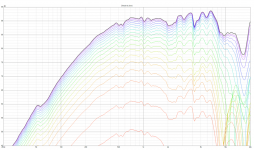 2022-10-11 09_24_41-VituixCAD_ C__Users_johnv_Documents_VituixCAD_Projects_cbt24-dipole-thing_...png155.2 KB · Views: 133
2022-10-11 09_24_41-VituixCAD_ C__Users_johnv_Documents_VituixCAD_Projects_cbt24-dipole-thing_...png155.2 KB · Views: 133 -
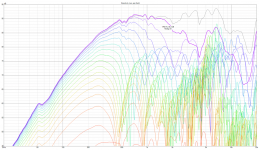 2022-10-11 09_27_31-VituixCAD_ C__Users_johnv_Documents_VituixCAD_Projects_cbt24-dipole-thing_...png235 KB · Views: 121
2022-10-11 09_27_31-VituixCAD_ C__Users_johnv_Documents_VituixCAD_Projects_cbt24-dipole-thing_...png235 KB · Views: 121 -
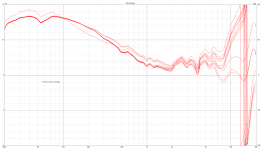 2022-10-11 09_29_56-Inbox (113,988) - john.vanommen@gmail.com - Gmail.png61.5 KB · Views: 127
2022-10-11 09_29_56-Inbox (113,988) - john.vanommen@gmail.com - Gmail.png61.5 KB · Views: 127 -
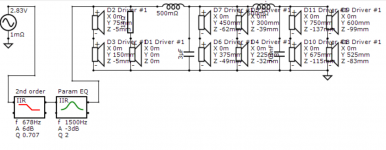 2022-10-11 09_30_59-VituixCAD_ C__Users_johnv_Documents_VituixCAD_Projects_cbt24-dipole-thing_...png30.3 KB · Views: 128
2022-10-11 09_30_59-VituixCAD_ C__Users_johnv_Documents_VituixCAD_Projects_cbt24-dipole-thing_...png30.3 KB · Views: 128 -
cbt24-dipole-thing.zip426.2 KB · Views: 62
Less than 5 degree vertical window?
I did some sims of a conventional CBT array, and it has a much wider vertical beamwidth, but the phase is a mess.
I guess the challenge is whether you want a wide vertical window or pinpoint imaging.
Tom Danley and I discussed this a few months back, in regards to his new speakers. Basically, both speakers were well received, but some preferred the pinpoint imaging of his new point source horn, while some preferred the spaciousness of his Paraline based speaker.
It really depends on the recording, IMHO.
That's them. Lots of ways to arrive at the same sort of result but for stopping sound going up a long vertical spread of the drivers is a simple answer.
A zero degree vertical windows is what's really needed.
You have a habit of over complicating things. 🤕
You have a habit of over complicating things. 🤕
You don't get it, that is far to practical.Not willing to add ceiling 'clouds'? View attachment 1098761
Solutions have to be overly complicated, technical and totally missing the point 😉
You hit it right on the head…..it depends on the primary monitors used during the original mix or remix process.….mastering shouldn’t have any effect of stereo phasing. There will literally never be one speaker to rule them all….most mixes are just garbage and it’s actually getting worse where the quest for loudness clouds everyone’s judgement.I did some sims of a conventional CBT array, and it has a much wider vertical beamwidth, but the phase is a mess.
I guess the challenge is whether you want a wide vertical window or pinpoint imaging.
Tom Danley and I discussed this a few months back, in regards to his new speakers. Basically, both speakers were well received, but some preferred the pinpoint imaging of his new point source horn, while some preferred the spaciousness of his Paraline based speaker.
It really depends on the recording, IMHO.
I am not sure line arrays will solve this problem. Theoretically their SPL only drops off at 3 dB at each doubling of distance, while that is 6 dB for a point source. That will make the problem even worse.So the speakers in the living room are literally firing straight into the master bedroom.
[...]
... the speaker situation is literally driving my wife crazy. Basically I do a lot of I.T. work in the middle of the night during maintenance windows, and being able to listen to some music or YouTube videos makes those maintenance windows go by so much faster. (Easily once a month I'm stuck on some troubleshooting call at 3am where my only responsibility is to stay up and wait for the network folks to fix some router.)
On the other hand, if sound quality is your main objective, I see merit in line arrays. There is less reflected sound from the ceiling.
Don't forget that you get very little sound directed outside the top and bottom of the array, the high vertical directivity contains it very well within the physical height of the line. The bedroom seems to be upstairs so there would be much less sound heading upstairs.I am not sure line arrays will solve this problem. Theoretically their SPL only drops off at 3 dB at each doubling of distance, while that is 6 dB for a point source. That will make the problem even worse.
My friend moved to a home with very high ceiling and it was quite annoying to be in, very echoy space, hard to have discussion with people for example. I believe its just ratio of plain surface area to amount of furniture which makes reverberation time longer, or something along the lines. It became much more comfortable place to be in, less echoy, just by adding some acoustic panels here and there. Line array would be fine solution for music playback in such room, but to have the space more comfortable in general I'd add some acoustic treatment as well, if at all possible.
I did some sims of a conventional CBT array, and it has a much wider vertical beamwidth, but the phase is a mess.
I guess the challenge is whether you want a wide vertical window or pinpoint imaging.
Tom Danley and I discussed this a few months back, in regards to his new speakers. Basically, both speakers were well received, but some preferred the pinpoint imaging of his new point source horn, while some preferred the spaciousness of his Paraline based speaker.
It really depends on the recording, IMHO.
I don't think you were thinking/talking about the vertical window in this reply. Horizontal window would make more sense.
I agree with a couple of other posters here, you're making this needlessly complicated.
Your main speakers, unshaded, with nearfield bass would be just about the ideal acoustic solution for John. Throw in a bit of room treatment and he's good to go.
Building in the arrays would up the wow factor a notch, IMO.
Building in the arrays would up the wow factor a notch, IMO.
In general I first would do some (R)T60 measurements on different positions.My friend moved to a home with very high ceiling and it was quite annoying to be in, very echoy space, hard to have discussion with people for example. I believe its just ratio of plain surface area to amount of furniture which makes reverberation time longer, or something along the lines. It became much more comfortable place to be in, less echoy, just by adding some acoustic panels here and there. Line array would be fine solution for music playback in such room, but to have the space more comfortable in general I'd add some acoustic treatment as well, if at all possible.
you're making this needlessly complicated.
story of my life lol
"When NASA started sending astronauts into space, they quickly
Discovered that ball-point pens would not work in zero
Gravity. To combat this problem, NASA scientists spent a
Decade and $12 billion developing a pen that writes in zero
Gravity, upside-down, on almost any surface including glass
And at temperatures ranging from below freezing to over 300 C.
The Russians used a pencil."
This is definitely something I would have done. Also, yes, I know the story is a myth 🙂
- Home
- Loudspeakers
- Multi-Way
- Hybrid Cardioid Speaker
